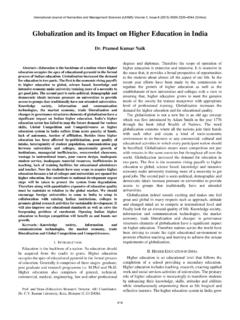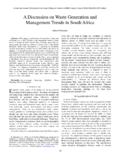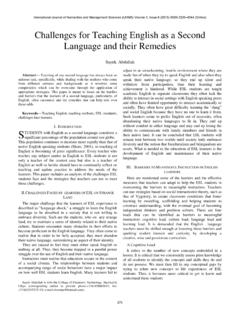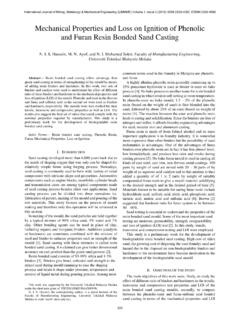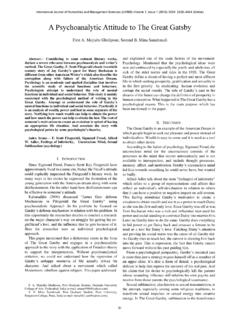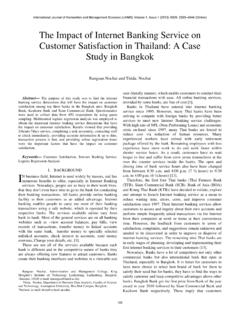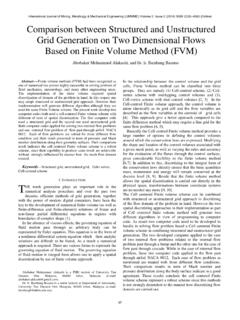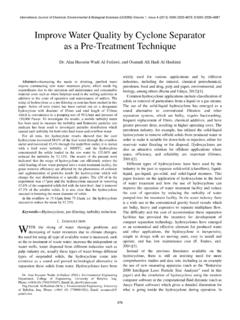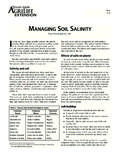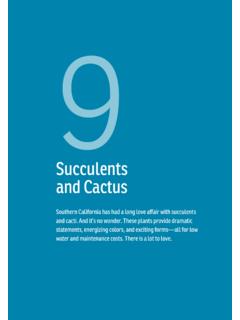Transcription of A New Approach to Reuse Alum Sludge in Pottery ...
1 Abstract This research discusses a new Approach to Reuse alum Sludge for Pottery manufacturing to ensure better environmental sustainability as well as economical value. alum Sludge is a by-product from drinking water-treatment process. Aluminum Sulphate Al2(SO4)3 is the most commonly used coagulant in Malaysia and many other countries of the world. As a result, tons of Aluminum Hydroxide-containing Sludge is unsafely disposed to the open environment daily. Water treatment plants are facing a serious problem of disposal of alum Sludge in a way that is both economical and environmentally sustainable due to the increasing cost of landfill and the limited space. This research is using combination of additives and thermal curing to stabilize shrinkage and strength properties of the Sludge . Fine granule of sand (silicon dioxide) has been used together with 75% of alum Sludge content and thermal curing up to 1200 Co.
2 The process of thermal curing allows the Sludge to be rapidly hydrated, hardened and transformed into pot s properties. Results have showed up to 85% utilization of alum Sludge can replace clay saving up to 300 tons per annum for a medium scale pot factory. As a result, the new ingredients for pot s manufacturing had achieved a substantial increase of profit margin for the manufacturer, a lower cost for the consumer as well as a much safer environment. This research comprises an effort towards green technology that can have direct positive impacts towards the environment, manufacturer as well as the consumer. Keywords alum Sludge , Pots, Thermal Curing, Green Material I. INTRODUCTION HIS research discusses a novel Approach to Reuse alum Sludge for manufacturing of building material and pots using admixtures and thermal curing in order to ensure better environmental sustainability as well as sound economical value.
3 alum Sludge is a potential environmental threat that is produced massively during the process of treating drinking water. There are many studies linked the free and complex aluminum to toxicity of the aquatic life (Driscoll et. Al., 1980) as well as a contributing factor to Alzhemer s disease . Aluminium Sulfate (Al2SO4) is the most commonly used coagulant in Malaysia and as a result, tons of Aluminum Dr. Faris Gorashi, Associate Professor at the Faculty of Engineering and Technology Infrastructure , Infrastructure University Kuala Lumpur (IUKL) Jalan Ikram Uniten 43000 Kajang Selangor ,Malaysia (Tel : +603-8738 3388; Ext 312 (office) Fax : +603-89256361 ,E-mail: ). Choong Choe Earn , Postgraduate student at the Faculty of Engineering and Technology Infrastructure , Infrastructure University Kuala Lumpur (IUKL) Jalan Ikram Uniten 43000 Kajang Selangor ,Malaysia (Tel : +603-8738 3388; Ext 312 (office) Fax : +603-89256361 ,E-mail: Hydroxide-containing Sludge is unsafely disposed to the open environment daily.)
4 In fact, The Semanggar Water Treatment Plant in Kota Tinggi, Johor alone generates an estimated 80 tonnes of dried Sludge per year.(Aminuddin, 2009). There are thousands of drinking water treatment plants world wide which use coagulant for efficient removal of particulate solids and collids thereby producing severeal tons of Sludge every year. (Babatunde AO, Zhao YQ 2007) alum Sludge is the main by-product from drinking water treatment processes. It is mostly sent to landfill. Due to the increasing cost of landfill (limited available land) and the needs for sustainable best practices, it became a necessity to look for alternative Reuse of the Sludge . alum Sludge can be used as a partial substitute in commercial clay brick (C. Elangovan, K. Subramanian,2011),(Mohammed O. R. , Hanan A. F. and Ahmed M. H,2008) , for improving particulate pollutant removal from sewage.
5 (Guan,Chen and Shang ,2005) and for using acidification process to recover alum Sludge and Reuse again(Amina A. A., Hisham A. H. and Ehab H.,2013). However, there are many alternative ways to Reuse the alum Sludge , but it is hard to achieve economic and environmental sustainable value. alum Sludge was like the clay fraction of soils (Awwa Research Foundation).So, it will have the similar properties of main raw material of manufacturing pot and building material which mainly consists of sandy clay. Hence, it has a big potential to be used for manufacturing pot and building material. This research aims to use a combination of additives and thermal curing to stabilize shrinking and strength properties of the Sludge to be used for Pottery and building material manufacturing. This research will comprise an effort towards green technology that can have direct positive impacts towards the environment, manufacturer as well as the consumer.
6 II. OBJECTIVES This research aims to create a new Approach that help to reduce the effect of the ever increasing alum Sludge produced by most water treatment plants in Malaysia and hence creating a safer and more sustainable environment. In order to accomplish the aim from this research, the following specific objectives and their expected results were set. 1. To Reuse alum Sludge in optimum amounts to preserve environment. Disposal of alum Sludge had always been challenging to water treatment plants management. The benefits of reusing alum Sludge are enormous and T A New Approach to Reuse alum Sludge in Pottery Manufacturing Using Silica and Thermal Curing Dr. Faris Gorashi Faris, and Choong Choe Earn International Journal of Chemical, Environmental & Biological Sciences (IJCEBS) Volume 2, Issue 3 (2014) ISSN 2320 4087 (Online)171 have positive multiple impacts that are measurable and directly contributing towards environmental sustainability.
7 It can significantly improve the quality of residual Sludge , Improve the quality of Sludge for a safer landfilling and hence reduce the risk contaminants leaching effects. There is an appreciable possibility that the disposed Sludge is able to meet the discharge standards set by the local/federal authority. Reusing the alum Sludge will also result on reducing the volume of the Sludge which surely will reduce the costs incurred for disposal. 2. To stabilize shrinkage of pots and building material under different temperature and admixtures proportion. Shrinkage of the Sludge used in manufacturing of Pottery and building materials is one of the most recurring problems due to the complex process involved however; The physical properties of Pots and building material can be enhanced by the addition of clay; the maximum percentage of water treatment plant Sludge is subjugated by configuring different Admixtures and temperatures.
8 3. To investigate the most suitable proportion of alum Sludge content for building material with the optimum strength. The physical properties of Pots and building material can be enhanced by the addition of clay; the maximum percentage of water treatment plant Sludge is subjugated by configuring different Admixtures and temperatures. 4. To determine the strength of building material in different proportion and different temperature. Determining the strength of building material is a potential factor in ensuring a high quality product that meets the stringent standards set by building materials regulating bodies. It is expected that the final product will significantly decrease the cost incurred in the production of building materials as well as a priceless eco-friendly solution to an existing problem faced by most water treatment plants in Malaysia.
9 III. SCOPE OF WORK The scope of this study is as follows: 1. Site visit to the study area to assess the amount and composition of alum Sludge . 2. Data collection for leachate at disposal sites. 3. To identify the optimum composition of admixtures for Pottery /building material manufacturing. 4. Micro-level analysis for stress and strain in granular assemblies. 5. Manufacture of prototype material. IV. BENEFIT OF THE RESEARCH This research will benefit in terms of providing a novel ingredient of raw material for pot manufacturers and building material manufacturers. As such, the research will contribute to the following: 1. To reduce the pollution which cause by alum Sludge 2. To solve the problem of disposal of alum Sludge which face by water treatment plant 3. To contribute efforts towards green technology that can have direct positive impacts towards the environment, manufacturer as well as the consumer.
10 4. To give the manufacturers an alternative choice for selecting raw material (clay or alum Sludge ). V. METHODOLOGY Fine granule of silicon dioxide will be used together with different proportion of 50%, 75% and 100% content of Sludge and mold into shape of pot under thermal curing up to 1200 Co and 1100 Co. Apart from that, the raw material for building material will be used together with different proportion of 50%, 60% and 70% content of Sludge , 30% ,40% and 50 % content of fine granule of silicon dioxide and granule of silicon dioxide and mold into the shape of building material under thermal curing of 1100 Co and 1200 Co .So, we can obtain the optimum amount of alum Sludge use for manufacturing pot and building material. By measuring the dimension of the pot and building material before processing thermal curing, we will be able to obtain the shrinkage of pot and building material after the thermal curing process.
